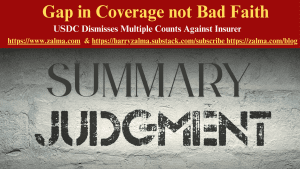Court of Appeal considers presumption of proximate cause in exclusion

In Brian Leighton (Garages) Limited v Allianz Insurance Plc [2023] EWHC 1150 Civ 8 the Court of Appeal construed the wording of a pollution exclusion and determined that it applied narrowly and only where pollution (or contamination) was the proximate cause of the damage.
The case concerned a fuel leak which contaminated the insured property. While the fuel leak gave rise to pollution or contamination, the parties agreed it was not the proximate cause of the damage. The proximate cause was penetration of the fuel pipe by a sharp object. The Court of Appeal overturned the first instance decision and held by a majority that the pollution exclusion required pollution or contamination to be the proximate cause of the damage so that the exclusion did not apply on the facts of this case.
BACKGROUND
The insured claimant (BLG) ran a garage business and was insured under a Motor Trade Policy (the Policy) provided by Allianz Insurance Plc (Allianz). This was an All Risks policy.
In June 2014 a fuel leak occurred on BLG’s premises after a sharp object ruptured a pipe which connected an underground fuel tank to six of BLG’s forecourt fuel pumps. The fuel leak contaminated the insured premises such that the BLG business had to be closed for health and safety reasons.
The insured brought a claim for material damage and business interruption under the Policy. Allianz denied cover on the basis of an exclusion (the Exclusion) which provided as follows:
“Pollution or Contamination”
Damage caused by pollution or contamination, but We will pay for Damage to the Property Insured not otherwise excluded, caused by:
a. pollution or contamination which itself results from a Specified Event
b. any Specified Event which itself results from pollution or contamination.”
It was common ground that no Specified Event (as defined in the Policy) had occurred.
At the point of appeal, the parties were agreed that the loss was caused by a process of contamination or pollution (the fuel leak) as part of the causative chain but that the proximate cause of the loss was the sharp object which had ruptured the fuel pipe, not the contamination or pollution itself.
The insured argued that the Exclusion applied only where pollution or contamination was the proximate cause of the damage. In contrast, the insurer contended that the Exclusion excluded cover where the contamination or pollution forms any part of the process in the chain of causation and the write-back in clauses a. and b. conferred cover where a Specified Event plays any part in the chain of causation whether more remotely or more immediately than the pollution or contamination.
DECISION
The Court of Appeal’s decision was split 2:1 with the majority granting the appeal and finding that the Exclusion did not apply.
Majority reasoning
The starting point was the general principle in insurance law that an insurer is only liable for losses proximately caused by a peril covered by the policy. However, the Court noted that this presumption is capable of being displaced, as expressed in Financial Conduct Authority v Arch Insurance (UK) Ltd [2021] UKSC 1:
“The requirement of “proximate” causation is based on the presumed intention of the contracting parties….But it is a presumption capable of being displaced if, on its proper interpretation, the policy provides for some other connection between the loss and the occurrence of an insured peril.”
The principal question for the Court of Appeal was whether the Exclusion displaced this presumption.
The Court noted that the language used gives rise to the presumption that the parties intended the Exclusion to apply to pollution or contamination as a proximate cause. This was reflected in the use of “caused by” which it was noted “has historically and uniformly been interpreted in this context as importing the concept of proximate cause”. It was further reinforced by the use in a different Section of the Policy to “directly or indirectly caused by” although the Court did note that caution should be exercised in relying on this contrasting wording when this particular Policy contemplated insureds selecting cover under some but not all Sections of the Policy and the meaning of the Exclusion must be the same for all insureds. Nevertheless the Court said that the contrasting wording:
“shows that the drafter had well in mind the distinction between “caused by” meaning proximately caused, and “directly or indirectly caused by” connoting a looser connection between the Damage and pollution or contamination, a distinction which is well established by judicial authority”.
The Court then looked to the construe the Exclusion as a whole including the write-back of cover in paragraphs a. and b. The Court found that the presumption was not displaced by the wording of the write-back because it was capable of being given meaning consistently with it. It also noted that the write-back wording is introduced by the words “caused by”. The Court found that paragraphs a. and b. of the write-back provision provided coverage where it would otherwise be excluded by the exclusionary wording. Paragraphs a. and b. were therefore engaged only where pollution or contamination was the proximate cause. The proximate cause presumption was, therefore, not displaced by the write-back provision.
The Court recognised that this construction gave the exclusion a narrow scope but said that this was not a reason to reject it. The Policy was to cover all risks of material damage (unless excluded). The risk of fuel leakage was an obvious risk for a business such as BLG (a garage) which meant a broad scope of coverage was desired. Such desire aligned with a narrow interpretation of the exclusion.
Dissenting judgment
It is worth noting the dissenting judgment from Males LJ. While he agreed with much of the majority reasoning, in his view the terms used in the Exclusion, when read in their entirety, sufficiently demonstrated an intention by the parties to displace the proximate cause presumption. In particular, when considering the write-back provisions and the list of Specified Events in the Policy which included “Fire, lightning, explosion,…storm, flood, escape of water from any tank apparatus or pipe….”
Males LJ noted what he called a “deliberate contrast” between the fact that “escape of water from any tank apparatus or pipe…” was covered as a Specified Event and the escape of fuel which was not, despite it being an obvious risk for the owner of a petrol garage. He also noted that fire and explosion are covered which are obvious consequences which may result from an escape of fuel.
He concluded that the purpose of the write-back provision was to ensure that where there is a Specified Event which causes or is caused by pollution or contamination, coverage would be provided. This suggested that the write-back provisions were not concerned with the proximate cause of damage and, therefore, the “caused by” language in the write-back did not mean proximate cause. Following the general principle that where parties use the same language in the same clause it is presumed to mean the same thing, this suggested that “caused by” in the opening of the Exclusion was not concerned with proximate cause.
Males LJ also found that no reliance should be placed on the wording used in other clauses within other sections of the Policy. The language in the Exclusion should be considered independently to derive meaning. This is because policyholders are entitled to select coverage under some but not all sections in a policy.
He also found that the construction of the High Court accorded with the natural and objective meaning of the Exclusion and he noted that the insured had not previously contended in the first instance trial that the Exclusion was limited to proximate cause. This point was only raised in the insured’s oral submissions on the appeal which Males LJ said was “powerful confirmation that the judge’s construction accorded with the natural meaning” of the Exclusion.
COMMENT
This case is an important decision for policyholders illustrating the contemporary approach of the Court of Appeal to causation in policy exclusions which also include write backs of cover. Such clauses are in common usage in a variety of contexts (well beyond pollution and contamination exclusions) and so the careful analysis of Popplewell LJ will be instructive in a range of situations. The case is a helpful reminder of the primacy of the principle of proximate cause but also the fact that and ways in which it can be displaced. It is also clear from the majority reasoning that if parties wish to depart from this presumption in a policy, clear language must be used.
Interestingly the Court of Appeal was mindful of the guidance from the Supreme Court in the FCA Test Case that the approach to construction should not be that of a ‘pedantic lawyer’ but rather a reasonable person in the shoes of an SME. That said, the Court of Appeal observed that both assureds and their brokers have access to legal advice and since policies in many fields contain terms of art which have acquired their meaning via use and judicial interpretation it is the duty of brokers to understand and, if necessary, advise assureds on them.
The split decision in the Court of Appeal also shows how difficult it can be to determine the parties’ intentions which, yet again, emphasises the need for clear language and thought to ensure that policy language reflects the risks which are to be transferred from insured to insurer.
KEY CONTACTS








